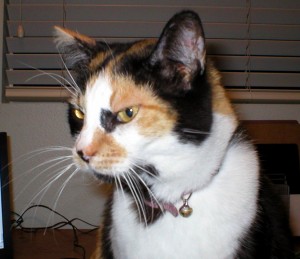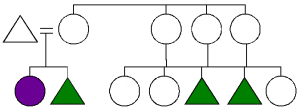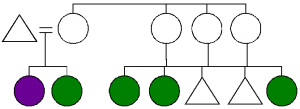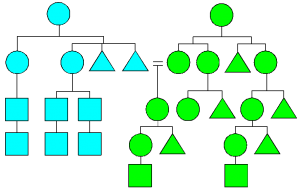
maxāntie
![]()
![]()
![]()
![]()
![]()
![]()
![]()
maxāntie
one’s lover, spouse, one’s special companion, perhaps a close sister or brother or lover, personally chosen kin of the same generation. One’s maxāntie does not necessarily start out as kin, though they can, but is otherwise considered to be one’s kin. They are not necessarily part of one’s clan, however, as that is governed by other rules.
makāe
![]()
![]()
![]()
![]()
makāe
one’s sister, brother, cousin, sibling or cousin of the opposite gender as oneself. [Plural makāji.]
So, if one is female (purple circle):

then all the green triangles are one’s makāji. Likewise, if one is male (purple triangle):

then all the green circles are one’s makāji.
matiē
![]()
![]()
![]()
![]()
matiē
one’s sister, brother, cousin, sibling or cousin of the same gender as oneself. [Plural matīji.]
So, if one is female (purple circle):

then all the green circles are one’s matīji. Likewise, if one is male (purple triangle):

then all the green triangles are one’s matīji.
maþūskīri
![]()
![]()
![]()
![]()
![]()
![]()
![]()
![]()
![]()
maþūskīri
The Kēleni see one’s kin as threads in a woven cloth. One’s makīri are the up and down threads (warp) and one’s maþūskīri are the side to side threads (weft). [See Wikipedia article on Weaving for more information on weaving.]
At it’s narrowest, maþūskīri means one’s father’s matrilineal kin. The meaning has expanded to include close friends, colleagues one interacts with every day, and other people one can reliably ask a favor of.
makīri
![]()
![]()
![]()
![]()
![]()
![]()
makīri
one’s kin, the people to whom one is related to by matrilineal descent. In the picture below, the two colors are two separate clans, and so two separate sets of makīri.

āñ, rājāñ, & rūjāñ
![]()
![]()
āñ
The modifier āñ is related to the word jāña, “middle”, So, āñ generally concerns itself with middle-ness. Combined with the directional prepositions, rā and rū, the concept becomes less clear. For example, rā NP āñ means, predictably, into the middle of NP or amid/amidst/among NP. If the NP is a large area, however, it can mean throughout NP. rū NP āñ, in contrast, means around NP or surrounding NP. So, with rā, āñ denotes a space (NP) and the thing spoken of is inside that space, not near an edge, and possibly in multiple spots inside that space. With rū, āñ again denotes a space (NP), but now the thing spoken of is specifically not inside that space, but rather outside of it, at multiple spots outside of it.
![]()
![]()
![]()
![]()
![]()
rājāñ
rājāñ is rā NP āñ without a specified location, and so means ‘to the middle’, ‘to among’, or ‘throughout’.
![]()
![]()
![]()
![]()
![]()
rūjāñ
Likewise rūjāñ is rū NP āñ without a specified location, and so means ‘surrounding’ or ‘around’.
Examples:
ñamma sāim makkepōlien rā anmārwi āñ pēxa
They became scattered throughout the world.
[pēxa is there for emphasis]
ñi sāim rū sāen āñ;
They gathered around him.
Note: That’s it for motion and direction, for now anyway. Feel free to ask questions about anything I didn’t cover. Next up, kinship and clan words, for a bit. After that, I’m not sure. Leave me a suggestion.
ālme, rājālme, & rūjālme
![]()
![]()
![]()
![]()
ālme
The modifier ālme is related to the noun jālme, which means ‘ford, crossing’. So the central definition of ālme denotes crossing something long and narrow from one side to the other, very much like ‘across’. ālme has expanded its range to include crossing any area, from one side of the area to the other side of the area. One border to the area must also be crossed. So one can start inside the area (at the edge, but inside) and cross to outside the area, or from outside the area to the opposite inside edge of the area, or from outside the area through the area and across the next border to outside the area again.
rā NP ālme is across NP and rū NP ālme is from across NP.
![]()
![]()
![]()
![]()
![]()
![]()
![]()
rājālme
rājālme is rā NP ālme without a specified location, and so means ‘across’.
![]()
![]()
![]()
![]()
![]()
![]()
![]()
rūjālme
Likewise rūjālme is rū NP ālme without a specified location, and so means ‘from across’.
ñi jahāþa rā jatōna ālme tō-kēñ;
Why did the “chicken” cross the road?
tō ñi rājakiē;
To get to the other side.
Friday Kitties

My food. Get your own!
Also, may I recommend a website for anyone who needs a dose of cuteness in their lives:
http://www.zooborns.com/
Complete with kitties:
http://www.zooborns.com/zooborns/2010/04/sand-cat-kittens-in-cincinnati.html
kiē, rājakiē, & rūjakiē
![]()
![]()
kiē
The modifier kiē refers to the observer’s other side of something, so something behind something else. This makes kiē partially synonymous with īr. The difference is that kiē refers to the observer’s position, and īr does not. If something has an obvious back, then use īr, otherwise use kiē. So, rā NP kiē is to the other side of NP and rū NP kiē is from the other side of NP.
![]()
![]()
![]()
![]()
![]()
![]()
rājakiē
rājakiē is rā NP kiē without a specified location, and so means ‘to the other side’.
![]()
![]()
![]()
![]()
![]()
![]()
rūjakiē
Likewise rūjakiē is rū NP kiē without a specified location, and so means ‘from the other side’.